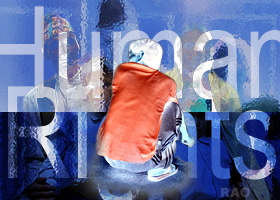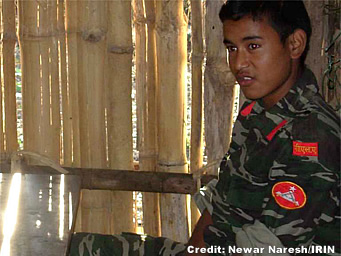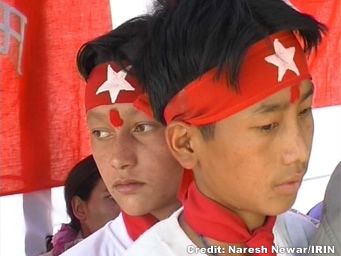|
Maoists
Should Release Child Soldiers - Recruitment Continues Despite Peace Agreement |
 |
New
York, February 1, 2007 (Human Rights Watch)
Nepal's
Maoist armed forces should immediately begin releasing the thousands of
child soldiers in their ranks and cease recruiting more children, Human
Rights Watch said in a report released today.
"
The peace agreement explicitly forbids the use of child soldiers, and complying
with this will be a key test of the Maoists' good faith to uphold the accord.
"
 |
| The
new 72-page report, "Children in the Ranks: The Maoists' Use of Child Soldiers
in Nepal," describes how the Maoists have continued using child soldiers,
and even recruited more children, despite signing a Comprehensive Peace
Agreement with the Nepali government on November 21. The peace agreement
commits both sides to stop recruiting child soldiers.
The
report, which is based on interviews with former child soldiers and Nepali
and international monitors, Publications how children as young as 14 served
on the front lines, received weapons training, and carried out crucial
military and logistical support duties for the Maoists. |
|
"The
Maoists should let the children go," said Sam Zarifi, Asia research director
at Human Rights Watch. "The peace agreement explicitly forbids the use
of child soldiers, and complying with this will be a key test of the Maoists'
good faith to uphold the accord."
Nepali
and international observers believe that up to 4,500 Maoist soldiers were
under 18 when they were recruited to fight in a decade-long civil war that
has claimed more than 13,000 lives.
 |
| A
young Maoist recruit in a camp in Surkhet.
The
Maoists, however, have consistently denied recruiting or using child soldiers.
When questioned directly by Human Rights Watch on November 18, the Maoist
leader Prachanda responded by repeating the Maoists' official line:
"We
have never taken the policy to recruit children into our army. But in our
military, they feed some children whose parents were martyred." |
|
Maoist
commanders at the local level have responded identically, or blamed the
use of child soldiers in the ranks on lack of discipline among local militias.
"Only
when the Maoists, from the top leadership down to cadres on the ground,
admit how many children are in their ranks and begin releasing them, can
Nepalis be confident that their children will no longer be recruited for
combat," said Zarifi.
Human
Rights Watch's report Publications how the Maoists have used a variety of
techniques for recruiting children. Maoists have kidnapped individual children,
have abducted large groups of children from school, and have used propaganda
campaigns to attract children as "volunteers." These practices were systematically
implemented over several years and throughout areas under Maoist control.
The
Maoists' practice of recruiting child soldiers, often forcibly, has caused
widespread fear among Nepalis and caused many families to flee their homes.
In
areas of the country under their firm control, the Maoists instituted a
"one family, one child" policy that forced at least one child from each
family to join the Maoists. When boys ran away or were sent away from home,
young girls were recruited.
"The
Maoists' use of child soldiers violates international law," said Jo Becker,
child rights advocate at Human Rights Watch. "Children under 18 should
not be allowed in the ranks, regardless of whether they were recruited
by force or through a propaganda campaign."
top
 |
| Child
supporters of the Maoists - many are kidnapped or coerced into serving
with the rebels
Since
the ceasefire that came into effect on May 3, no children have been involved
in combat. But the Maoists continued recruiting children up to the signing
of the peace agreement and, with less frequency, have continued to recruit
children even afterwards.
The
report also Publications the failure of the Nepali government to attend to
the needs of child soldiers. Until the recent ceasefire, Nepali security
forces treated children accused of cooperating with the Maoists with the
same brutality that they used against adults suspected of Maoist ties.
|
|
The government has not yet created a system to assist child soldiers who
leave Maoist forces.
Human
Rights Watch called on Nepal's major international donors - such as the
United States, the European Union, India and the United Nations - to provide
technical and financial assistance necessary for reintegrating former child
soldiers into normal life.
"Release
from the Maoists' ranks is only the first step for thousands of children
who have missed out on their education or learning how to earn a living,"
Becker said. "The Nepali government and international supporters have a
responsibility to help these children."
Since
2002, the Maoists have been named in three consecutive reports by the UN
secretary-general to the Security Council as violating international standards
prohibiting the use and recruitment of child soldiers. On February 9, a
UN Security Council working group on children and armed conflict, is scheduled
to consider reported violations against children by all parties to Nepal's
armed conflict. The working group will make recommendations for Security
Council action.
"The
Security Council should make it clear to the Maoists that they must immediately
end their practice of using child soldiers," Becker said. "This would remove
a source of agony for thousands of Nepali families and boost the likelihood
of a lasting peace in Nepal."
| Credit
Human Rights Watch 2007 |
 |
|
|
Report
2007 Children
in the Ranks
The
Maoists' Use of Child Soldiers in Nepal

I.
Summary and Introduction Key recommendations Methodology

II.
Background The civil war's impact on children The People's Movement
and the Comprehensive Peace Agreement

III.
Recruitment and Use of Child Soldiers The Maoists' denials "Voluntary"
enlistment Recruitment campaigns

IV.
Forced Recruitment Box: Govinda's abduction Recruitment of child soldiers
after the ceasefire

V.
Treatment of Children in the Ranks In the line of fire Weapons training
Combat support Attempts to escape Box: Ram's escape

VI.
The Government's Detention of Former Child Soldiers and Failure to Provide
Rehabilitation Assistance Detention of children Pre-ceasefire mistreatment
of children in detention Lack of rehabilitation and reintegration programs
for former child soldiers

VII.
International Legal Standards

VIII.
Detailed Recommendations |
 |
PDF-File
1.6
MB |
|
|







